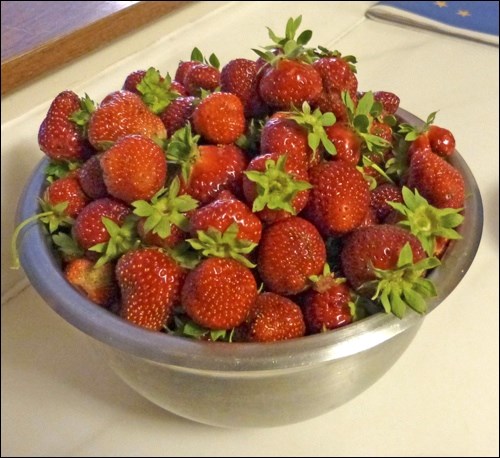Two years ago in late spring, I decided on a new strawberry patch, fenced to exclude my large strawberry-loving dog. A local nursery recommended Seascape. I took their advice and put in a row of 25 plants.
They soon began producing. The fruit is large, glossy bright red, firm, sweet and delicious. The berries are conical to round and bright red throughout. The yields are high and they keep producing into fall. The berries are good for fresh eating, processing into jams and sauces and freezing.
Seascape is a day-neutral type meaning flower buds (and hence fruit) develop regardless of day length. They bear lots of fruit in their first year and produce flowers, fruit, roots and runners simultaneously. While many day-neutral varieties develop few runners, Seascape does so with abandon.
I was somewhat surprised to learn that the University of California introduced ‘Seascape’ in 1991-92. Developed for the California strawberry industry, it also proved very successful with commercial growers in the northeastern United States. It is believed to be the most productive of any day-neutral strawberry. It is heat-tolerant (great for our hot dry prairie summers) and has a very high degree of disease resistance. Some of its success comes from ability to flower and set fruit in a wider range of temperatures, up to 30 C.An adaptable variety, Seascape does well in containers, hanging baskets and traditional garden rows.
Select a location in full sun with well-drained soil. I have mostly sandy soil, so I added generous amounts of peat moss, well-rotted manure and compost. If your soil is heavy clay, add the above with an equal volume of coarse sand. I then raked the soil to make a slightly raised row about four inches higher than the surrounding soil and two feet wide.
Set the plants about a foot apart at the same level as they were in the nursery containers. Water well so that the moisture penetrates to the full depth of their root system and into the soil below. Apply a balanced granular fertilizer along one side of the row according to package directions.
Then apply about a three-inch layer of clean straw on both sides of the plants so that the soil of the entire raised row is covered. The mulch serves a number of purposes: it keeps the berries clean; reduces mud splash that could carry soil-borne diseases (e.g. botrytis) that cause fruit rot; conserves moisture; and suppresses weeds. Top up the straw layer each spring.
Keep the row weed-free by hand pulling or using a hand hoe, being careful to avoid injuring the strawberry roots. Ensure the plants receive about one to two inches of water per week. In baskets or containers, check them daily.
Once fall temperatures drop to -5 C, lightly cover the plants with five inches of additional well-fluffed straw (optional). Gently rake this straw aside in the spring. However, my row has now gone through two Saskatchewan winters un-mulched and unscathed.
I did not bother to transplant the many new plants at the end of the runners until this spring. I simply dug them up in early May and moved them to a new second row handled in the same manner as the original row. They never blinked and began flowering and producing immediately.
Seascape, yeah!
Sara William is author of the recently expanded and revised Creating the Prairie Xeriscape and with Hugh Skinner of Gardening Naturally, A Chemical-free handbook for the Prairie.
— This column is provided courtesy of the Saskatchewan Perennial Society (www.saskperennial.ca; hortscene@yahoo.com; www.facebook.com/saskperennial). Check out our Bulletin Board or Calendar for upcoming garden information sessions, workshops, tours and other events. GardenLine is back for the season to help solve your gardening glitches. FREE. Phone (306) 966-5865 or email gardenline@usask.ca.



